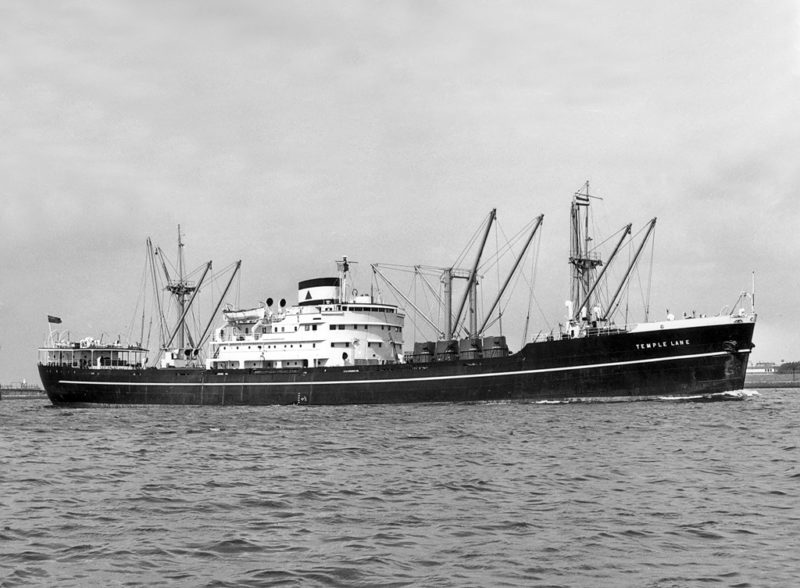
Francis Devereux Lambert (1817-1891) set up in business on his own account in 1841 at the age of 24 years in London, and joined the Coal Factors Society on 11th September 1841. However, he had roots in Newcastle, with his eldest brother, Mark William Lambert, and his father, Mark Lambert, active in the printing business that became part of the Andrew Reid & Co. Ltd. print business in Newcastle, and later the Hindson Reid Print Group of Newcastle. Francis Devereux Lambert had moved to London in the 1830s to work in the insurance and coal factor businesses of Sir James Duke, a Sheriff and Alderman of the City of London.
Unfortunately, Francis Devereux Lambert became completely blind from the age of 40 years from a disease of the optic nerve, then incurable, and died in 1891 aged 74 years. His elder son of the same name was born in 1841 and later joined the Coal Factors Society together with his younger brother, who also joined the Coal Factors Society, and with their father they were then able to run the shipping and coal businesses of Lambert, Ridley & Company (formed in 1845) and Lambert, Son & Scott (formed in 1869) as the eponymous ‘Lambert Brothers’.
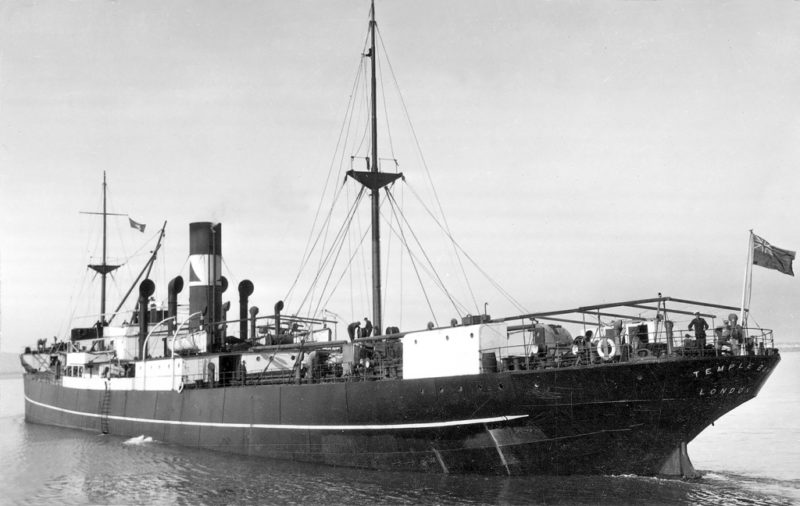
GROWTH OF THE LAMBERT BROTHERS FLEET
The Lambert Brothers became shipowners in 1878 when the 119 ton wooden schooner Exhibition was purchased. She was appropriately named as she had been built in the year of the Great Exhibition of 1851. Several small steamers were then purchased for the coal trade from the Tyne and South Wales to London, including Terlings of 1871, Jubilee of 1867, Kenley of 1877, and all built of iron and purchased from Young, Ehlers & Company of London. Larger new colliers of well over 1,500 dwt were then built for the company in the 1880s including Kent and Merthyr and culminated in three fine colliers completed in the 1990s in Cookham, Ocean and Surf. The collier owning era of the concern ended after twenty years when ten colliers were sold off to William Cory & Son in Medway, Kent, Merthyr, Burham, Pelaw, Vernon, Cookham, Walker, Ocean and Surf.
The deep sea tramping trades were then entered in 1900 with the new tramps Agnes and Edith from the S. P. Austin yard at Sunderland The Commercial Steamship Co. Ltd. was purchased from Young, Ehlers & Company in 1905, with four more tramps joining the fleet in Darlington and Plympton of 4,500 dwt and the larger Manaton and Taunton of 6,500 dwt. Plympton of 4,500 dwt was wrecked in August 1909 with the others sold off around that time, leaving a three ship fleet in 1913 of Agnes, Edith and Hurstdale of 4,500 dwt purchased in 1910. The Commercial Steamship Co. Ltd. had connections with Willem Ruys of Holland, who had founded the Stoomboot Reederij Rotterdam-sche Lloyd in 1875 which became Rotterdam Lloyd in 1883. Three ships were transferred from Lambert Brothers to Rotterdam Lloyd in 1881 in Wyberton built in 1872, Hampton built in 1873, and Torrington built in 1874 and were given Dutch names, with Wyberton and Torrington returning to Lambert Brothers in 1891 and resuming their original names. The Commercial Steamship Co. Ltd. gave Lambert Brothers their funnel and houseflag of a red equilateral triangle, used for the next century.
A limited liability company, Lambert Brothers Ltd., was set up in 1902 and continued at the same address in London of 85 Gracechurch Street that had been used for several decades. The first Chairman of the company was Newton Dunn, who had joined Lambert Brothers in 1876 and was made a partner in 1892. Lambert Brothers Ltd. had ownerships of coal depots, and were coal exporters, foreign coal exporters, shipowners and ship and insurance brokers. Newton Dunn lived in Eltham in North London and continued as Chairman of the company until the 1920s, his five fellow directors in 1919 being Leonard Hinton, Alfred F. Scott, R. Rattcliff Steel, E. S. Tylke of Cardiff, Graham Wallis and A. F. Fawcus. R. Rattcliff Steel later became Chairman of the company and remained as such until 1960, with the Steel family also represented on the Board by Robert W. Steel. The Hinton family also continued to be represented on the Board by Geoffrey Hinton, who was Deputy Chairman of the company in 1960. The export of iron ore from Bilbao into U. K. ports required a subsidiary company of Ybarrola Depositos de Aceite Combustible S. A. to be set up in Bilbao to handle the bunkering and agency needs of Lambert Brothers ships.
Agnes and Edith were sold off in late 1913, with Hurstdale then sunk early in the Great War by the cruiser Karlsruhe off Brazil on 23rd October 1914 when 205 miles from St. Paul Rocks while on a voyage from Rosario to Hull with maize. A number of small ships were managed for the Shipping Controller during the rest of the war including a few owned by DFDS of Copenhagen, as well as L. H. Carl of 1,916 grt and built back in 1898 by the William Gray yard at West Hartlepool for D/S Gorm of Denmark, and became a war loss on 20th July 1917. Ship management was to be a major feature of Lambert Brothers during the interwar years.
The collier Ocean was a former member of the fleet and had passed to the ‘Black Diamond’ fleet of William Cory & Son in 1896, and became a war casualty off Hartlepool. She was commanded at the time of her loss by my maternal great grandfather Capt. Henry Edwin Norman of South Shields when she was torpedoed without warning four miles north east of Hartlepool on 23rd November 1917. Capt. Norman was trapped in his cabin with the steel door, normally left open for a quick exit, slammed and jammed completely shut by the force of the explosion. He had a narrow escape from death, suffering severe dislocated shoulders and other injuries while forcing a way out of the cabin. He was unable to resume command as Cory Commodore until the war was over.
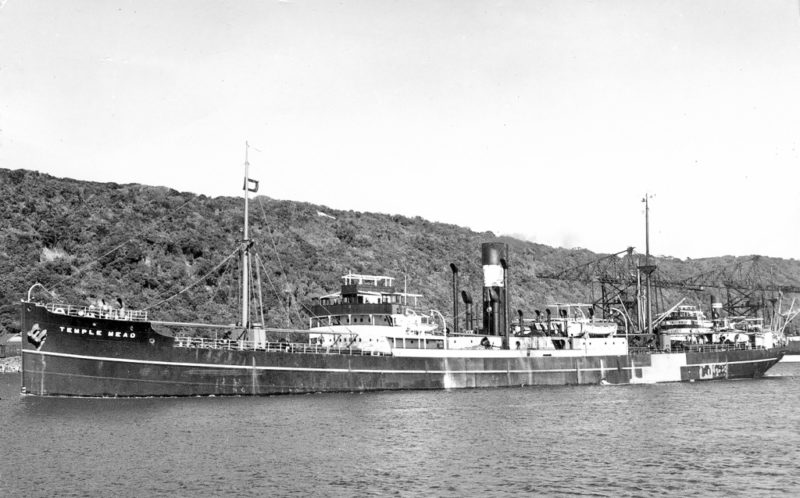
The Ministry of Shipping had appointed Lambert Brothers in 1914 as coaling agents at Gibraltar for the duration of the war. Lambert Brothers operated a pooling arrangement to supply the bunkering and coal merchants of Gibraltar and received a remuneration of ten shillings per ton of coal. When the wartime coal pool was closed on 15th March 1919, a huge discrepancy was found in the remaining actual coal stocks and that was declared by the company in its accounts, resulting in a court case between the company and the Inland Revenue in 1921.
Lambert Brothers did not resume shipowning and ship management until 1923, when the small tramp Tintern Abbey was purchased from Abbey Line of Cardiff and was traded for a few months. A substantial holding was also taken in 1923 in the Temple Steamship Co. Ltd., set up in London in 1921 and managed at the time by Temple, Thomson & Clark Ltd., but Lambert Brothers Ltd. took over as managers in 1926 when it became a wholly owned subsidiary. At the time of acquisition Temple owned only one vessel, the steam collier Snake of 2,655 grt, and she was owned only for a few months until sold to French owners. The Newcastle built deep sea tramp Kitty Taylor was managed for Newcastle owners from 1929 before being sold to Ropner of West Hartlepool in 1934 and renamed Daleby. The ships of the Dornoch Shipping Co. Ltd. of Glasgow were also managed from 1936 to 1954 after a small financial interest was taken in the company, including Dornoch, Coulmore, Coultarn, Dornoch (2), Coulbeg, Coulbeg (2), Coulbreck, Coulgarve and Coulgorm of between 5,000 dwt and 10,000 dwt. Coulmore had a long bridge deck ‘midships and a pronounced counter stern, whereas Dornoch had no bridge deck ‘midships and was given a modern cruiser stern.
The Middleton Steamship Co. Ltd. was another managed company, with Darcolm and Darleny of 8,000 dwt purchased in 1937, with Darcolm renamed Middleton and Darleny renamed Temple Yard under the Temple Steamship Co. Ltd. Darcolm, Darleny and the first Dornoch had their triple expansion steam engines boosted by a low pressure steam turbine to increase their service speeds. The Primrose Hill Steamship Co. Ltd. was another managed company, this time for London Greeks Rethymnis & Kulukundis.
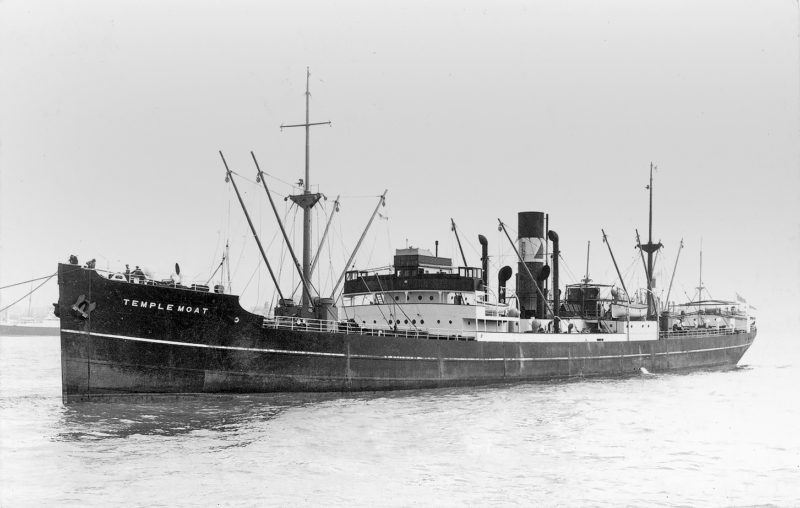
RETHYMNIS & KULUKUNDIS
Manuel E. Kulukundis and Minas Rethymnis arrived at Dover in the early 1920s with little money but the knowledge of how to manage tramp steamers and act as ship’s agents. The pair were joined by four Kulukundis brothers and then by another cousin, Basil Mavroleon. Sale and purchase and management of tramps for London Greek owners was a major part of the Lambert Brothers portfolio in the inter-war years, with many London Greeks obtaining their first tramp via help from Lambert Brothers sale and purchase department. The Counties Ship Management Co. Ltd. was set up in 1937 by Rethymnis & Kulukundis, and managed British flagged tramps as well as 45 Greek flagged tramps in 1939 for themselves and all of their associates, of which 21 were given ‘Mount’ prefixes to their names, and unfortunately only four of these survived the war in Mount Kyllene, Mount Helikon, Mount Rhodope and Mount Aetna. Rethymnis & Kulukundis also purchased a record 33 war built tramps in the early post-war years for trading under the Red Duster.
A tramp tanker arm was set up by Rethymnis & Kulukundis in 1948 as London & Overseas Freighters Ltd. (LOF), which after trading for 55 years from London was moved back to Greece in 2003 and all of its London office records and ship models were disposed of. Counties Ship Management was still trading two dozen war built tramps in 1960, and Basil Mavroleon was later to build ore carriers and bulk carriers at the Southwick yard of Austin & Pickersgill Ltd. in Sunderland and part of the LOF Group.
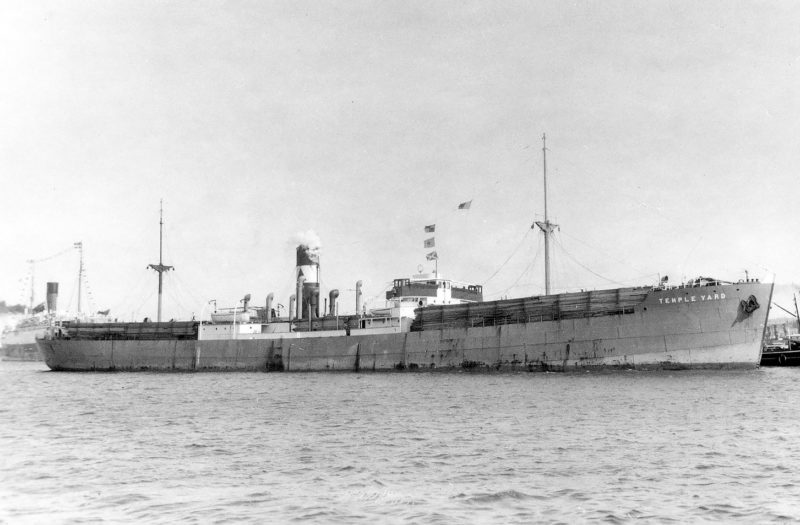
LAMBERT BROTHERS INTER-WAR TRADING
Seven new tramps of 8,500 dwt had been built from 1928 by Clydeside and Wearside shipbuilders for the Temple Steamship Co. Ltd. in Temple Bar, Temple Lane, Temple Mead, Temple Moat, Temple Pier, Temple Arch and Temple Inn, with the last pair built with finance from the Shipping Loan Scheme of the late 1930s. They were five hold tramps with black hulls and a white line, and with number three hold separating the navigating bridge from the engineers accommodation and also acted as the cross – bunker hold. This septet traded worldwide with voyages beginning with a full coal cargo from U.K. ports to Alexandria as a long term contract to supply the Egyptian bunker coal trade had been obtained. The Temple tramps then went through the Suez Canal to load several cargoes of coal and salt in South Africa for Aden or India, and then return homewards from Australia with grain or wool cargoes via the Pacific and the Panama Canal, or by the Suez Canal, or by loading in South African ports.
An interesting purchase in late 1932 was the twin funnelled cargo liner Dovenden from the McAllum Steamship Co. Ltd. of London. She had been in lay-up at New York and Rotterdam since 1930, and continued in lay-up for Lambert Brothers until sold for £7,500 in January 1935. She had seen much better times though when completed in 1910 as Howick Hall for Charles G. Dunn & Co. Ltd. of Liverpool and his New York & South American Line to Latin America and South America. A shelter decker with a deadweight of 8,079 tonnes, her profile was impressive with a long combined fo’c’stle and bridge, twin funnels, and a well deck aft. Yellow funnels with black tops and white diamonds around central red and blue bands added to her appearance. However, by 1915 she had been sold to an American competitor, the precursor of the Isthmian Line. After sale by Lambert Brothers to Italians, she carried Italian military supplies to Massowah during the Abyssinian War. She was taken by the U. S. Government in 1941 while lying at Jacksonville and renamed Raceland, and was bombed and sunk in a Russian convoy to the south of Bear Island in March 1942.
Temple Lane of 1928 was sold to Greek owners in 1937 and renamed Panaghia but was wrecked in March 1938. Temple Bar became a total loss in April 1939 when she struck a rock off Carroll Island and sank 20 miles south of Cape Flattery in British Columbia while on a voyage from Miami to Yokohama with scrap. The timber carrier Terlings was completed by Lithgows at Port Glasgow, and recalled the name of a steam collier operated on the North East Coast when Lambert Brothers first became shipowners. She had two long holds, one forward and one aft of the accommodation and navigating bridge, with a total of eight derricks to load and unload the timber cargoes, and traded almost exclusively in sawn timber from Archangel until her loss in 1940 to German bombers. Five company tramps were to be lost during World War II to enemy action.
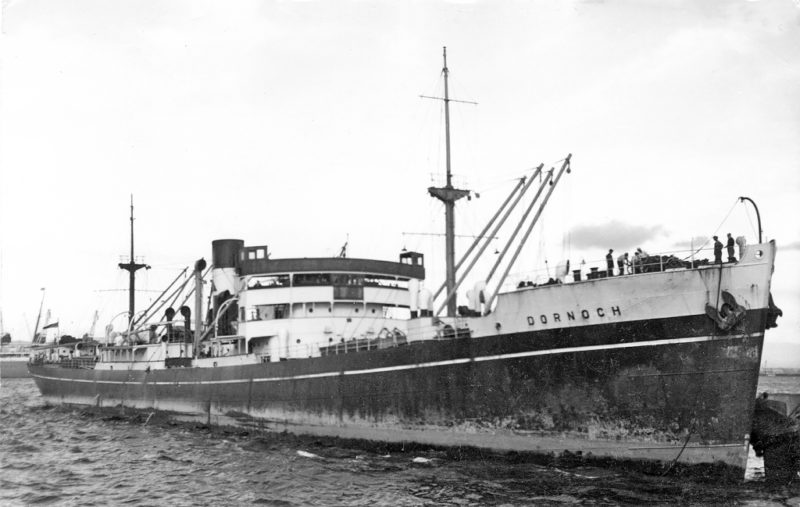
WORLD WAR II
Temple Pier was taken at Algiers on 17th June 1940 by the Vichy French authorities while on a voyage from Cardiff to Algiers with coal. She was abandoned to insurers, and badly damaged and sunk by aircraft attack at Tunis on 14th December 1942, and was refloated in 1946 and taken to Sfax and Genoa for repairs for new owners.
Terlings was bombed and sunk on 21st July 1940 10 miles south west of St. Catherine’s Point on the Isle of Wight while on a voyage from London to Southampton to Sydney (NS) in ballast, 10 crew lost.
Temple Mead was bombed and sunk on 21st January 1941 off West Ireland while on a voyage from Rosario to the U.K. with cereals.

Temple Moat was torpedoed and sunk by U69 on 23rd February 1941 to the south of Iceland, she had previously been damaged by bombing on 5th January 1941, all of her 42 crew were lost. She had straggled from convoy OB288 outbound for Canada from Loch Ewe.
Coultarn was torpedoed and sunk on 30th March 1941 to the east of Cape Farewell while on a voyage from Hull to Mobile in ballast, 3 crew lost.
Convoy SC121 from New York on 23rd February 1943 with 61 ships including Coulmore was one of a series of hard fought convoy battles before the tide of the war swung towards the Allies. U229 surfaced at night on 9th March and fired torpedoes at point blank range at Coulmore and the South Wales tramp Nailsea Court. The latter exploded amidships killing her Master Capt. Lee and 42 others. Coulmore was luckier, although badly damaged by a torpedo she was able to make port under her own steam to fight in a convoy another day.
Ships of varying nationalities had been managed for the Ministry of War Transport during the war, and Lafontaine Park and Fort Ellice and three more war built tramps continued in this way in the early post war years. The surviving tramps Temple Yard, Temple Arch, Temple Inn, Dornoch, Coulbeg, and Coulgorm were joined in 1946 by the smaller new tramp Coulbreck and her sister Coulgarve in 1949, both from the Lithgows yard at Port Glasgow. The former German Australian Line cargo-liner Stolberg of 6,035 grt built back in 1913 by Flansburger Shiffsbau was briefly in the Lambert Brothers fleet renamed as Victoria Peak during 1946/47 before being passed to Wallem & Company of Hong Kong. She had a forward well deck and had served the Union Steamship Company of New Zealand for 26 years as Waiotapu from 1919 to 1945 after bring ceded to the Shipping Controller as a war prize in 1919.
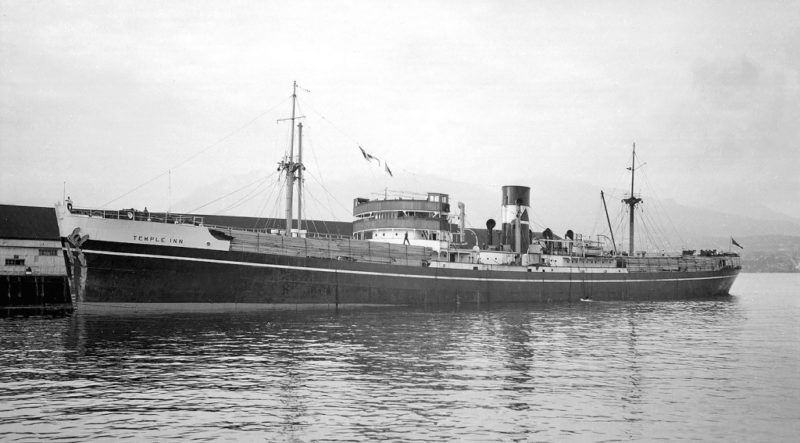
POST-WAR TRADING
Coulbeg of 1940 and Dornoch of 1939 were sold in 1951/52 to the Nile Steamship Co. Ltd. with Glen & Company as managers and renamed Jutland and Dunrobin respectively. Lambert Brothers remained managers of the Dornoch Shipping Co. Ltd. until 1954 when management passed to Glen & Company and then both the Dornoch and Nile companies were purchased by the newly formed Harrisons (Clyde) Ltd. in 1956 and managed by the Harrison family of the former Gow & Harrison partnership of Glasgow. Coulgarve and Coulbreck of 5,000 dwt and built in 1949 were renamed Dunolly and Dundrennan in 1954, and Dornoch of 1939 was renamed Vennachar in 1957 after all had passed to the Harrison family.
Fort St. James was purchased in 1946 and renamed Temple Bar (2), and she sailed in ballast from the Tyne to Wilmington (NC) on 16th August 1954 and ran into a hurricane and rolled violently before reaching her destination. On arrival, she was chartered to carry tobacco on charter to States Marine Lines of the U.S.A. for a series of three voyages to Liverpool, and wore the funnel colours of her charterers. She then made two voyages with scrap metal from Philadelphia to Rotterdam, before being chartered in April 1955 to T. & J. Harrison of Liverpool at London West India Dock for a round voyage to the Caribbean visiting Barbados, Grenada, St. Lucia, St. Vincent and the Grenadines, and Trinidad. She wore the white and red band colours of her charterer of ‘two of fat and one of lean’ and loaded sugar at Georgetown in British Guiana for the return voyage to Liverpool. She then was chartered for a single voyage to carry iron ore from Freetown to the Tees, having regained the red triangle funnel colours of Lambert Brothers. She then made from August 1955 a series of fifteen Transatlantic voyages from Baltimore, Hampton Roads or Newport News with coal for the Continental ports of Rotterdam, Amsterdam or Hamburg over the next sixteen months until the end of 1956.

A replacement tramp newbuilding programme got underway in 1954 with the launch of the five hold Temple Hall of 10,405 dwt at the Dundee yard of the Caledon Shipbuilding & Engineering Co. Ltd. She was fitted ‘midships with a four cylinder 2SCSA Doxford type oil engine of 3,600 bhp to give a service speed of 12 knots. She sailed from Dundee on her maiden voyage to load at Leith, Newport, Liverpool and Glasgow for a series of two voyages on charter to T. & J. Harrison to East and South African ports. She then loaded coal at Hampton Roads for Mexican ports and Los Angeles before transitting the Pacific to Nagoya, Kobe, Moji and Yawata for the return voyage to Bremen and Rotterdam via Panama.
Temple Hall then sailed from Rotterdam on 19th February 1955 for Port Arthur to load iron ore for Piraeus, and then loaded more iron ore at Monrovia for Baltimore, followed by coal from Hampton Roads for Antwerp. She then loaded coal at Barry for the St. Lawrence and iron ore at Seven Islands for Mexican ports and Los Angeles before again transitting the Pacific to Yokkaichi and Kobe for the return voyage to Bremen and Rotterdam via Panama. She then made a voyage in January 1956 from Dunkirk on charter to a French company to East African ports and Mauritius to load sugar for Algiers, Cadiz, Bordeaux, Le Havre and Dunkirk. She then made two voyages with iron ore from Seven Islands to South Wales and was then briefly laid up at Cardiff, before sailing on 2nd November 1956 with coal for the Mediterranean ports of Malta and Limassol returning to Newport. She then loaded iron ore at Vitoria in Brazil at the end of 1956 for Hamburg followed by coal from Hampton Roads for Manchester. She sailed down the Manchester Ship Canal on 26th March 1957 to load at Eastern Seaboard ports of the U.S.A. for Brisbane, Sydney (NSW), Melbourne, Geelong, and Burnie. She loaded grain at Adelaide and Fremantle for Manchester via Aden and the Suez Canal, and then moved round to the Tyne for dry docking and painting, arriving in the Tyne on 7th September 1957.
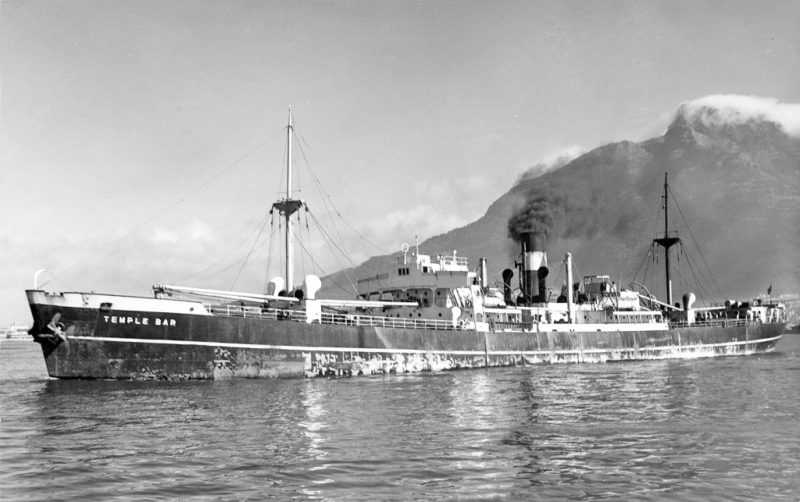
Two sisters of Temple Hall were completed as Temple Lane (2) at the Lithgow yard in 1954, and Temple Main at the Caledon yard in 1958, and spent much time in trading around the Indian sub continent as well as in worldwide tramping. The trio were very modern motor tramps and had excellent crew accommodation, all in separate cabins and with different wood panelling in every cabin. The war built steam tramp Coulgorm had been renamed Temple Mead (2) in 1953 and transferred from the Dornoch Shipping Co. Ltd. to the Temple Steamship Co. Ltd. but was sold in 1955. The war built tramps of Temple Bar (2), Temple Arch and Temple Inn could not compete with the modern motor tramps by 1958/59 and were laid up alongside each other at Wrabness on the Stour just upstream of Harwich before being sold off in 1959 to the Chandris family of Greece, Temple Arch becoming Marihora and Temple Inn becoming Mariviki with both later becoming marine casualties. Temple Bar (2) was sold to Hong Kong owners in 1959 and was renamed Nord Sky and then to Chinese owners in 1960, being broken up in China at a later date.
Lambert Brothers Ltd. later became a subsidiary of the Hill Samuel Group in 1968, and this group were to provide the finance to enter the bulk carrier era. The trio of five hold motor tramps from the 1950s were sold off to Greek owners in 1968/69, with an order placed for a bulker of 22,000 dwt with the Norwegian yard of Horten Werft for delivery in 1969. Temple Arch (2) was managed by the Scottish Ship Management grouping of Hugh Hogarth & Sons Ltd. and Lyle Shipping Co. Ltd. Lambert Brothers Ltd. had first made contact with this group in 1963 when they were prepared to purchase a bulker and bare-boat charter it to Lyle for ten years, but nothing came of this.

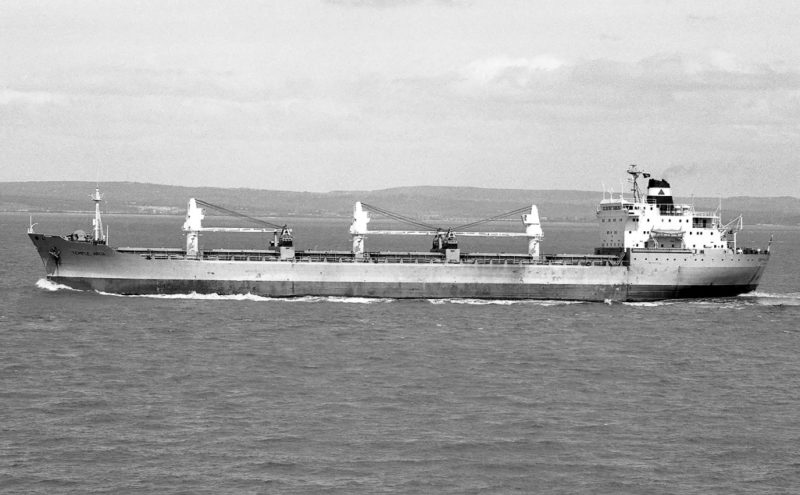
Scottish Ship Management were able to secure contracts of affreightment for Temple Arch (2) to carry pyrites, concentrates, British steel to the Great Lakes, coal and timber in the Australian market, as well as phosphates from the Pacific islands to Australia for the British Phosphate Commissioners, but carrying an Australian crew if long term chartered in that Pacific trade. Three sister bulkers were then ordered, with two from Upper Clyde Shipbuilders Ltd. and delivered in 1971 as Temple Bar (3) and Temple Hall (2), plus a slightly larger twin funnelled sister of 23,700 dwt from Haugesunds M. V. in 1972 as Temple Inn (2). Freight rates were very good until the fuel oil price spike in late 1973 and a dip in the market, and profits were high but were held back by the need to re-engine all four bulkers during 1973/74. The original Ruston & Hornsby diesel engines proved to be extremely unreliable, continuously breaking down at sea as little sea testing had been done. Temple Bar (3) had a serious engine room explosion to the north of Djarkarta in 1973 and was completely disabled until help arrived in the bulker Cape Wrath, also managed by Scottish Ship Management, with Temple Bar (3) then towed to Singapore.
Scottish Ship Management then re-engined all eleven bulkers under their management (four from Lamberts, four from Hogarths and three from Lyle) with Stork Werkspoor diesel engines. The entire production capacity of the shipyard and engineering works of the Amsterdam Drydock Company were then taken over while each bulker was at the yard for six weeks. The bulkhead in front of the engine room had to cut to remove the old engine and fit the new one. Time was lost by each bulker having to reposition before coming on hire again in Australasia to the charterer.
Lambert Brothers Ltd. replaced Scottish Ship Management by Whitco as managers in 1975, with Temple Inn (2) transferring to the management of Salen (U. K.) in 1977, after she had been chartered for a year from 1976 to Northwood Mills of Vancouver to carry timber from Vancouver to Cardiff. R. V. Wood was Chairman of the company with Richard C. Hope as Managing Director of the company at this time with a Board of nine further directors. The quartet of bulkers continued to operate in Australian, Pacific and worldwide trading until 1977 when Temple Bar (3) was sold for Great Lakes service, and was subsequently lengthened and renamed Lake Nipigon and later Algonorth. She was placed in lay up in the Great Lakes with damage in December 2008 and arrived for breaking up at Sault Ste Marie in Ontario on 18th July 2012.
Temple Hall (2) was sold at the end of 1977 to Stolt Nielsen for conversion into a gravel discharge vessel, and arrived at the Stavanger yard of Moss Rosenberg Verft on 10th January 1978 for the work to be carried out, being renamed Seaway Sandpiper and later Sandpiper as a stone dumping ship by Boskalis of Holland before arriving for breaking up at Aliaga in Turkey on 13th September 2013. Temple Arch (2) was sold to Cypriot owners and renamed Solitaire, while Temple Inn (2) was sold to Greek owners and renamed Cape Antibes in late 1978. One of the last voyages ever made by a Lambert Brothers Ltd. vessel was that of Temple Inn (2), sailing from Antwerp on 7th October 1978 with steel for U. S. West Coast ports and arriving at San Diego in early November, one hundred years after the first such voyage for Lambert Brothers Ltd. The company remained in business as ship’s agents and managers.
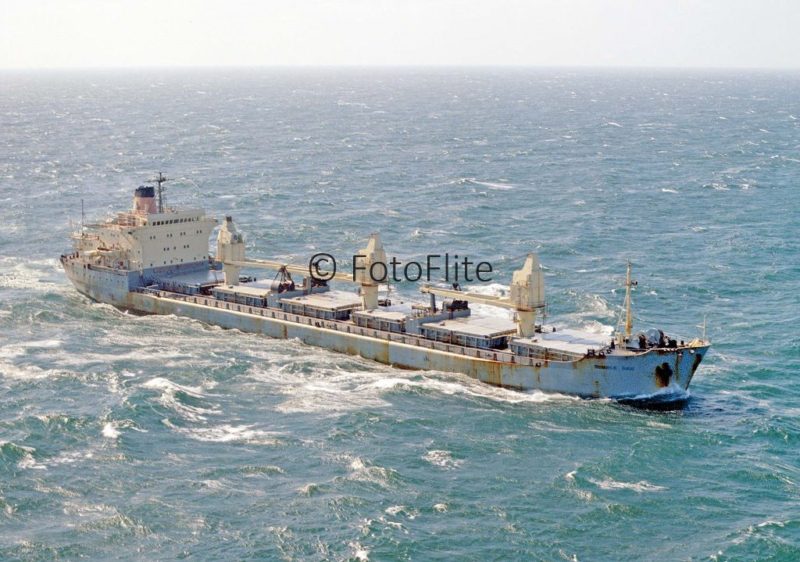
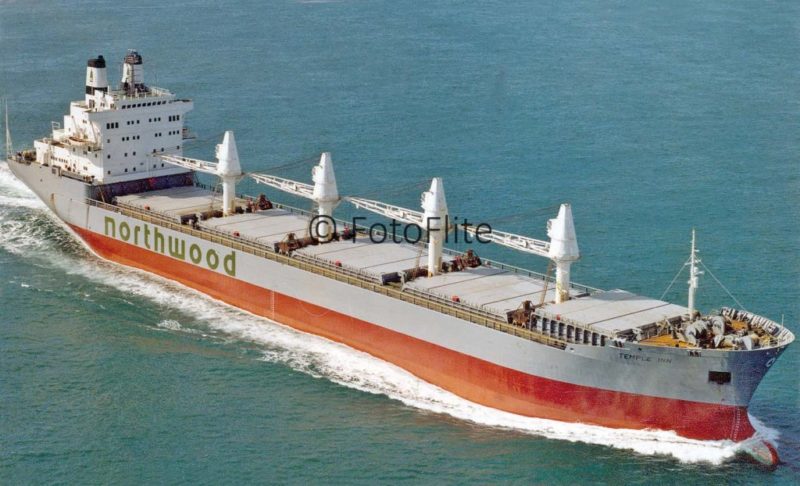
POSTSCRIPT
The five hold motor tramp Temple Hall of 1954 was sold to Greek owners in 1968 and renamed Pantelis, becoming Telamon in 1977. She was beached at Arrecife on Lanzarote on 31st October 1981 while on a voyage from West Africa to Greece with logs after taking in water and leaking badly with her decks under water. She was beached in an inlet just to the north of the coastal road from the Muelle de los Marmoles in Arrecife harbour and near an oil fired power station, with the waves, currents and winds working the vessel badly until all three forward holds were lost plus her diesel engine. The ‘midships superstructure with blue painted funnel, her aft two holds and her stern have remained in situ for almost forty years, despite a Lanzarote Cabilde (Council) proposal to remove the wreck for scrap steel in 2017. The project failed as no commercial enterprise would take on the removal project, and I was able to photograph her superstructure and aft two holds in February 2020 while on holiday on the island.
Lambert Brothers Ltd. continued in the ownership of the Hill Samuel Group after being sold off in 1968, who in turn passed the company to the TSB Group Plc and then in May 1992 to the Inchcape Group, although today it is still owned by TSB and registered as Endeavour Marine Services. Endeavour Quay in Portsmouth Harbour is a leading yacht boatyard, and was formerly the famous Camper & Nicolsons yacht building yard at Gosport, which today still builds yachts up to 40 metres in length and weighing up to 180 tonnes. Lambert Brothers Shipping Ltd. was a subsidiary company incorporated in September 1985 but closed and dissolved four years later in May 1989. Lambert Brothers Ltd. was a great tramping company with many other business strands to its name, and is remembered by the many seafarers that served in the ships, and has a long history beginning in 1841 and thus spans almost two centuries of maritime history.
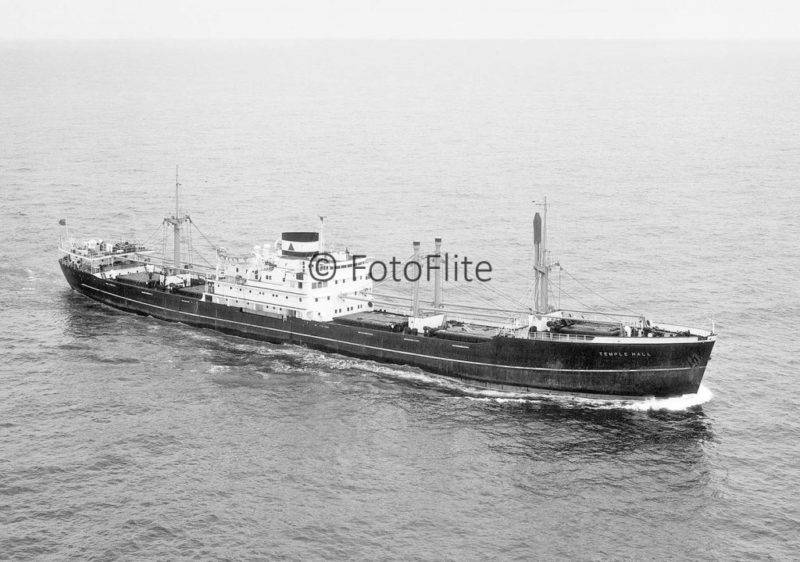
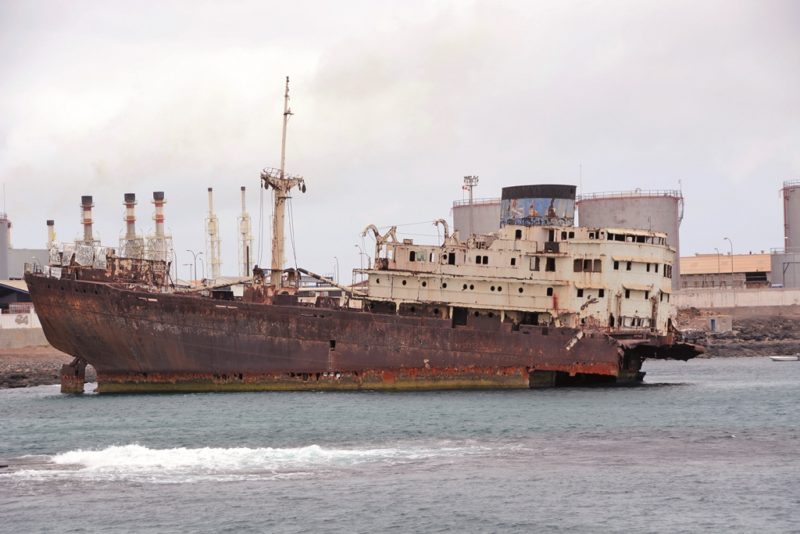

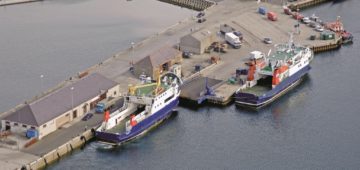



Comments
Sorry, comments are closed for this item